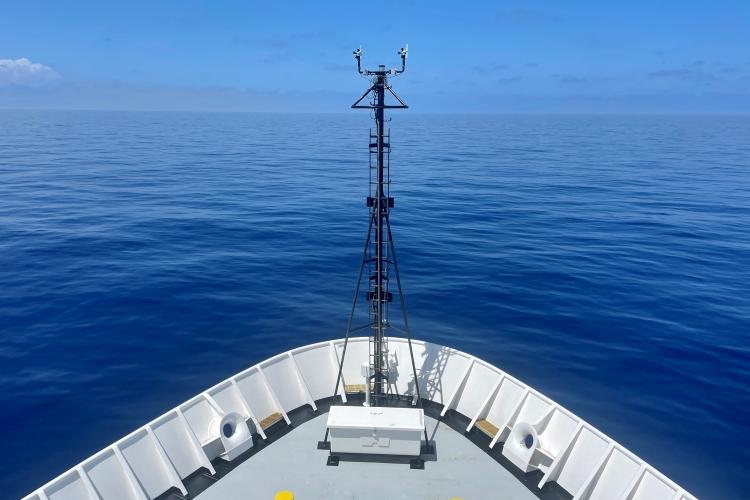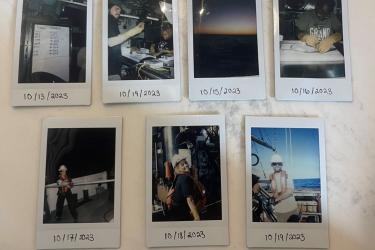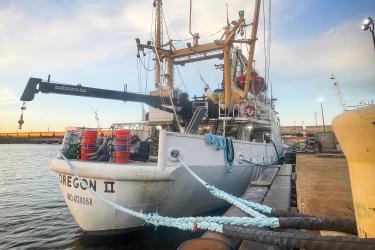Follow along with scientists for frequent updates during the first segment of the Vessel Surveys For Abundance and Distribution of Marine Mammals and Seabirds project. Read about sightings, unique findings, and other happenings aboard the Gordon Gunter in the Gulf of Mexico.
Day One: The Weather Couldn’t Stop the Team
The thunder rolled and the lightning did strike (cue Garth Brooks), but the crew was able to squeeze in a few hours of work during the day, as the clouds broke. It was looking like it might be a rocky start due to weather, but the science team was able to set up and deploy the towed hydrophone array to collect acoustic data, as well as visually observe for a few hours. It was a great day to set the equipment, prepare for sightings during the project, take advantage of some observation time, and complete the checklist of safety drills aboard the ship.
The bird specialists contracted by the U.S. Fish and Wildlife Service started us off with the first sightings of the survey! They spotted and identified more than 20 birds, such as royal tern, band-rumped storm petrel, and sooty tern, through the hand-held binoculars.
Dr. Chris Haney, a seabird scientist on the survey explained, “It was a good start! All marine bird sightings provide great data. On this survey, it would be really neat to see the black-capped petrel because the comment period opened back up to relist the bird as a threatened species through the Endangered Species Act.”
The marine mammal and seabird teams have big goals for collecting data to help inform plans to restore populations in this region. Thus, the team is hoping to have many productive days out here!
Day Two: First Successful Full Day of Many
Excitement kicked in for the awaited first full day of visual observation and acoustic work, as the sun came out. The crew was prepared to accomplish the many tasks at hand. The observers were able to make a handful of sightings despite varying conditions throughout the day. The bird specialists sighted and identified more than 40 birds, such as brown boobies, flocks of sooty terns, and small groups of Audubon’s shearwaters. The acoustic team’s highlight was detecting echolocation clicks from three sperm whales as the day reached its final hour.
“This survey has four observers searching for animals at all times within our working hours. We normally work 12- to 13-hour days and rotate scientists through various observation stations. We also have a single scientist sitting in the lab to record sightings as they occur,” Jesse Wicker, marine mammal scientist explained.
An interesting sighting during the day for the mammal observer team was a whale that could have been either of two species: pygmy or dwarf sperm whale.
A fun fact about both the dwarf and pygmy sperm whales: They have the ability to release a dark fluid, often referred to as “ink,” to defend themselves when feeling startled or attacked. This fluid is created by their rich diet of squid, octopus, and other members of that family. This gave them the nickname “firecracker whales.” Our team did not see this reaction occur, but it is something interesting to know about a marine mammal that you can share amongst your peers.
At the end of the day our acoustics team detected sperm whale echolocation clicks. The passive acoustics team monitors sounds picked up by the hydrophone array throughout the entire day while the visual observers are searching for animals. This is especially helpful when the hydrophones pick up sounds made by animals that are underwater that the observers cannot see. The hydrophones also pick up sounds produced by animals the visual observers are monitoring, which can help scientists match sounds heard to the species producing the sounds.
“Sperm whale clicks are very distinctive, making them easy to identify to species,” Melissa Soldevilla, an acoustician, describes, “The clicks can be detected for up to approximately 10 km (approximately 6.2 miles).”
Day Three: Glassy Water Equals Lots of Sightings
It was a pristine, glassy water kind of day! The crew woke up with their glasses half full and hopeful for a busy field day.
The visual observer team made a plethora of sightings and were presented with an excellent opportunity to gain additional information for a previous survey.Two groups of pantropical spotted dolphins came near the trackline and rode the bow long enough to collect four more biopsy samples.
Carrie Sinclair, a marine mammal scientist explained, “This was a great opportunity to add to the already existing set of data collected from the previous study for the pantropical spotted dolphin in this area. We were excited about how smoothly it went for the team.”
The passive acoustics team decided to add more weight onto the passive acoustic array to move it deeper in the water column. That’s where sounds from marine mammals propagate better and are further away from noise made by wind and waves. Scientists heard sounds from a lot of different animals throughout the day, which provided crucial data and augmented the information collected from the sightings.
Some sighting highlights from the birding team included black-capped petrels and black-bellied whistling ducks.
Overall, it was a successful start to the survey. The team will continue their mission to collect more data on marine mammals and seabirds in the northern Gulf of Mexico. Stay tuned!
Meet the blogger
Ellie Hartman
Ellie Hartman was born and raised in Breckenridge, Colorado. She was a communications intern, research assistant, and marine mammal observer for NOAA's Southeast Science Center. She graduated from Barry University with a Master's of Business Administration and graduated from University of Miami with a Master's of Professional Science in Marine Conservation. Meet Ellie








